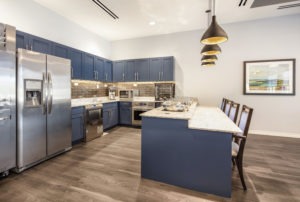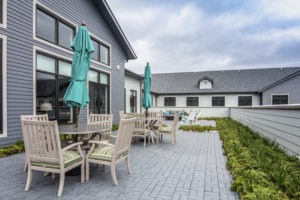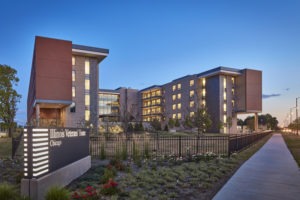How COVID-19 Could Bring a Resurgence of the “Neighborhood” Planning Model

Drew Roskos, AIA with HED
The COVID-19 pandemic has proven to be particularly difficult to contain in senior living facilities, where many staff and residents are often concentrated in large buildings.
Between the high population density, frequently traveled common areas, and shared communal surfaces in dining halls, the traditional design of senior living buildings has proven to contribute to the disease’s spread. After the pandemic is over, could more facilities turn to the neighborhood planning model?
The Benefits of the Neighborhood Planning Model
The neighborhood model offers many advantages. Rather than have all residents use the same communal areas like dining halls, a neighborhood model features a smaller dining room and living room in each smaller “neighborhood.” Many of these facilities feature homelike living spaces like individual apartments or suites, further allowing for resident privacy.
These facilities tend to feel more like homes. The design encourages residents to engage in smaller groups, but by visiting other “neighborhoods,” residents can still interact with many different people. This type of residency can also encourage physical activity in residents.
This model also offers distinct advantages when it comes to controlling disease transmission. Drew Roskos, AIA with HED, notes that facility owners and operators considering the neighborhood model have been focusing not only on resident social activity levels, but also on disease prevention and containment and models that allow a business to run more safely and effectively.
“I believe that the neighborhood model allows residents to “quaran-team” – maintaining contact with a small group while separated from others – to allow for safe social participation and that the increase in interest for this model is justified, especially as we develop a long term view of the issue and as we look at how this will work for other levels of care with higher acuity,” says Roskos.

HED Atria at RiverTrail. Bolingbrook, IL. Photo credit: Matt Dula
Roskos also explains that the neighborhood model offers construction benefits, too. It’s versatile in that it can be implemented with modular construction. That’s a particular benefit in rural or suburban areas, where generous site sizes make modular construction deliveries simpler. “The development of a network of smaller communities can be a useful solution to staffing issues in these less dense areas,” notes Roskos.
The neighborhood model is also practical in urban areas, where smaller communities using the model can help residents to engage with community resources. “For example, small stand-along communities can occupy smaller parcels of land or can be a part of a mixed-use development,” says Roskos.
Neighborhood models offer residents and owner/operators plenty of benefits. According to Roskos, this model helps to build a sense of ownership in residents. Facilities can quickly implement this style, and the separate buildings of a neighborhood model can be built specifically for certain types of care or certain types of residents.

HED Atria at RiverTrail. Bolingbrook, IL. Photo credit: Matt Dula
Roskos recently finished construction on the Illinois Veteran’s Home, a skilled nursing facility that will provide care to 200 veterans. This facility is a prime example of how the neighborhood model can be used to provide certain types of care. “It’s a supportive method to address the unique characteristics of the aging veteran community,” notes Roskos.
Overcoming Barriers to the Neighborhood Model
This model isn’t without its challenges, though. Roskos explains that neighborhood model facilities have higher construction costs. Because residents are spread out, staff, including food services, are under greater demands. Equipment may need to be duplicated throughout the different buildings.
“The neighborhood model places a large focus on a high ratio of staff to residents,” Roskos advises. He recommends that a facility interested in exploring this model confirm its staffing numbers before moving forward. A facility might consider a hub and spoke model across a region to leverage staff coverage and to help offset higher construction costs.
As an alternative, facilities might explore mixed use developments. “In mixed use urban developments, the smaller community can fit within the larger development and though financing can be complicated, it can provide a way to share the burden of developing new construction in an urban setting,” explains Roskos. This can be an ideal solution for denser settings.

HED Illinois Veterans’ Home. Chicago, IL. Photo credit: Patsy McEnroe
The neighborhood model has been criticized for not increasing positive interaction and socialization between seniors. “I disagree with that,” says Roskos. “Neighborhoods have the potential for significant bonds and relationships, but a downside is it also has opportunity for conflict.”
Looking to the Future
Embracing the neighborhood model offers a facility distinct advantages when it comes to disease control, and the current pandemic is evidence of how important it is to design facilities with this in mind. With other benefits like creating a more homelike environment and the potential for fast implementation, it’s easy to see how this model could become a popular option for the future of senior care facilities.

Paige Cerulli is a contributing writer to i Advance Senior Care.
Related Articles
Topics: Administration , Departments , Design , Facility management , Featured Articles , Housing , Infection control , Operations , Resident Care , Senior Environments











